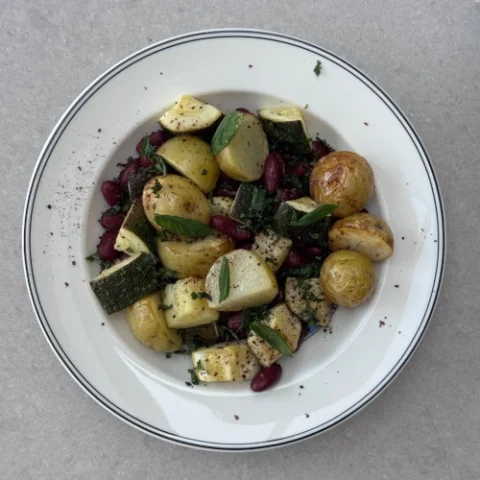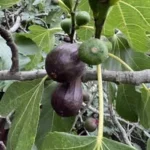
Wholesome Roasted Vegetables & Red Kidney Bean Salad
Ingredients
- 1 courgette
- 1 tin red kidney beans
- 300g new potatoes
- 1tbsp olive oil
- 1-2 tbsp lemon juice (half lemon)
- ½tsp sumac
- Fresh mint, sea salt flakes
Instructions
- Preheat the oven to 180°C.
- Meanwhile, cut the potatoes and courgettes into mouth-sized bites.
- Mix the olive oil, lemon juice, salt, potatoes, and courgette well.
- Put on a baking tray and cook for 20 minutes.
- Chop the mint, keeping some leaves to decorate.
- Mix the beans, roasted vegetables and mint.
- Serve with mint leaves and sprinkle with sumac.
Introduction
Red kidney beans are a staple ingredient in kitchens worldwide. Recognisable by their distinctive kidney shape and deep red colour, these humble beans have earned a place in countless recipes – from hearty stews and chillies to refreshing salads. Beyond their culinary versatility, red kidney beans are rich in nutrients and have an intriguing history that dates back thousands of years.
Origins of Red Kidney Beans
The red kidney bean (Phaseolus vulgaris) is native to Central and South America. Archaeological evidence suggests that beans were cultivated by early civilisations more than 7,000 years ago. They were a dietary cornerstone for the ancient peoples of Peru and Mexico, often grown alongside maize and squash in the traditional “Three Sisters” farming system. Spanish and Portuguese explorers introduced kidney beans to Europe in the 15th and 16th centuries, and from there, the beans spread to Africa and Asia. Today, they are enjoyed worldwide and form a vital protein source in many cuisines.
Nutritional Profile
Red kidney beans are considered a nutritional powerhouse, particularly for individuals following a plant-based diet. Here’s what makes them so beneficial:
-
Protein: Kidney beans are an excellent source of plant protein, offering around 24 grams of protein per 100 grams of dried beans. This makes them particularly valuable for vegans and vegetarians.
-
Fibre: With both soluble and insoluble fibre, kidney beans aid digestion, support healthy cholesterol levels, and help maintain steady blood sugar.
-
Vitamins and Minerals: They are rich in folate (essential for red blood cell formation), iron (crucial for energy and oxygen transport), magnesium (supports muscle and nerve function), and potassium (essential for heart health).
-
Low Glycaemic Index: Kidney beans release energy slowly, making them an excellent option for sustained energy and balanced blood sugar.
Health Benefits
The combination of protein, fibre, and micronutrients makes red kidney beans a true superfood. Regular consumption has been linked to:
-
Improved digestion and gut health.
-
Enhanced satiety, which supports healthy weight management.
-
Reduced risk of cardiovascular disease thanks to their fibre and antioxidant content.
-
Stable blood sugar levels, which can be particularly beneficial for people with type 2 diabetes.
Cooking and Preparation
It’s important to note that red kidney beans should never be eaten raw. They contain a naturally occurring toxin called phytohaemagglutinin, which can cause stomach upset if beans are undercooked. The good news is that proper cooking completely eliminates this risk. To prepare dried kidney beans safely, soak them for at least 8 hours, then boil vigorously for 10 minutes before simmering until tender. Tinned kidney beans are pre-cooked and safe to use straight away – making them a convenient option for quick meals.
Fun Facts About Red Kidney Beans
-
Kidney beans come in several varieties, including light red, dark red, and mottled speckled beans.
-
In India, kidney beans are known as rajma and are the star of the famous North Indian dish, rajma curry.
-
The “Three Sisters” agricultural method, where beans grow alongside maize and squash, allowed beans to climb maize stalks while providing nutrients back to the soil.
-
During the 19th century, kidney beans became a staple ingredient in American chilli recipes, especially in Texas.
-
A single cup of cooked kidney beans contains nearly half the daily recommended intake of fibre.
Conclusion
From their ancient roots in the Americas to their current status as a kitchen essential, red kidney beans have a fascinating story to tell. Brimming with protein, fibre, and essential minerals, they offer a wealth of health benefits while adding depth, texture, and colour to countless dishes. Whether you’re preparing a comforting stew, a protein-rich salad, or a spicy curry, red kidney beans are a wholesome and versatile ingredient that truly stands the test of time.



